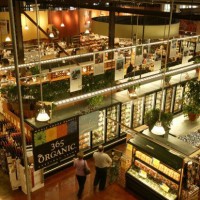Our online worlds are full of colors, words and sounds but lack something major scents. Could that ever change?

When David Edwards founded the oPhone, he hoped scent messages would become the next big thing in the digitisation of our online lives.
The device looked like a high-tech cruet set, and allowed a friend with an iPhone app to send you bespoke olfactory messages alongside photos. Send a picture of your dinner, tag it with four different tones, and whoevers on the receiving end can sniff it from the vase-like tubes of the oPhone.
Right now, nobodys waking up at 3am saying, I really want to send a scent message, Edwards told the New Yorker in April this year. But one day they will.
The oPhone didnt take off, and the company has now shifted focus to a scent speaker called the Cyrano, which similarly uses a range of scent capsules to emit playlists of smells.
Compared to our real world interactions, our online lives are devoid of scent an underrated but powerful part of our sensual world.Our digital cultural, so soaked in visual and aural stimuli, is odourless. So why didnt his marriage of smell and picture messaging excite more interest?
From a technical point of view, smell is simply harder to mass communicate than sounds and pictures. There are two main technological obstacles to making smell transmissible by digital means, explains biophysicist and author of Perfumes: The A-Z guide, Dr Luca Turin.
First, there are no odor primaries like RGB or CMYK. That means you cannot obtain the full gamut of doors from mixing a few. Second, it has, for mysterious reasons, proved impossible to stimulate the olfactory epithelium directly by any means tried so far. This means that it is currently impossible to elicit a sensation of smell without there being an actual chemical in the inhaled air.
But as well as these significant scientific barriers, scent occupies an uneasy position in our modern culture.
The hankering for artisanall scent
Scent is big business in 2016. An estimated 2,400 new fragrances will launch this year, and amongt these are a growing number that position themselves as artisanal scents emphasising the connection with physical materials rather than abstract nouns. Artist and composer Paul Schtze has sought to create perfumes based on personal memories of storms and old books, while Louis Vuittons CEO Michael Burke has said he wants to company to move towards the creation of artisanal fragrance that harks back to the ways they used to be conceived of and purchased. Why?
If you have craft beer, and clothes being made by hand in a small boutique, youll also have perfumes that have that artisanal feel to them, explains Dr Morgaine Gaye, a food futurologist and one of the curators of this years FutureFest in London. However the irony is these perfumes are artificially made. Theyre molecules constructed by chemistry as opposed to real molecules from nature. So although it may look artisanal, the reverse is often true.
The reasons behind our generations hankering for craft experiences are nebulous, drawing on everything from disposable incomes to dwindling trust in international corporations. In terms of digital culture, however, the desire for something with the whiff of craftsmanship is arguably a counterpoint to a life increasingly lived online.
While projects like the oPhone long to bring olfactory experiences into digital communication, perfumes that emphasise their (albeit illusory) connection to natural scents move in the opposite direction, scratching an itch technology cant.
The more were plugged into the virtual world, the more we deeply appreciate the contrast moments in our human experience, says designer and olfactory artist Mindy Yang. Intuitively, we realize that we are starved of certain sensations. With the rise of digital culture, society has, perhaps subliminally, become more interested in the missing sense what we smell.
This interest in scent isnt only happening within the worlds of perfume and fashion. Over the past few years a number of cultural projects have set out to focus on the power of sensory experiences, from the use of a smell map at Hampton Court Palace for an olfactory tour of the smells of a royal palace, to the Tate Sensorium, which in 2015 let users experience visual art alongside smells, tastes and sounds. Artists such as Victoria Adams, Brian Goeltzenleuchter and Rachel Morrison, to name a few, all position scent as a core part of their practice, pulling on ideas of personal memory, tactility and the power of scent to evoke feelings of desire.
We are defenceless to smell
There is commercial interest in leveraging this power. Yang is exploiting this to creates scents specifically designed for individual brands. Similar to lighting and sound design, I compose invisible frequencies that sets the tone in the physical space, she explains. There is no guard against a fragrance as an emotional trigger so long as one is not anosmic [unable to discern smell]! Done right, olfactive marketing is an incredibly powerful tool.
The olfactory system in our brain has a close relationship with the limbic system, which is strongly involved in a persons emotional life. This gives scent the power to affect our emotions in a way that is much more direct than visual and auditory stimuli. While we may have developed certain barriers to the predictable tropes and rhythms of poster and radio adverts, the effect of smell is much harder to block. You can understand why companies want to tap into it.
You can not look, and you can not listen, but you cant not breathe, says Gaye. So you cant not smell. So you dont have a choice. The brands that are doing it more cleverly are the ones where you dont know it is happening. You never question it. Nescaf, with the glass jars with plastic lids and foil, have been embedding the smell of Nescaf in the labels for decades, so you smell it off the shelf. You smell it as a brand, but you dont know youre smelling it.
Gaye also tells me about a tactic used by the London toyshop Hamleys, which pumps out the smell of pia colada because it makes the parents linger longer. Techniques like these are hard to control, however, with sensory effects being so unpredictable depending on everything from specific cultural associations to the days weather. But that isnt stopping brands trying to stoke involuntary emotional responses to their products, though.
Department stores and coffee jars arent the first to connect scent to involuntary feeling. The seductive control of the senses has been dabbed on the wrists of churches, brothels and hospitals throughout history to ease us, to soothe us, to excite us. Odors have a power of persuasion stronger than that of words, appearances, emotions, or will, writes the German author Patrick Sskind in his 1985 novel, Perfume: The Story of a Murderer. The persuasive power of an odor cannot be fended off, it enters into us like breath into our lungs, it fills us up, imbues us totally. There is no remedy for it.
Whether its devices likes the oPhone trying to introduce scent into digital messaging, or olfactory brand strategists that want to leverage our limbic systems, organisations are growingly aware of our cultures desire for sensory experiences. In a time of virtual reality and scentless social networks, its perhaps no wonder that we as a culture have such a desire for something that instinctively feels real and authentic even if it was made in a lab.
Read more: https://www.theguardian.com/technology/2016/sep/16/smell-digital-technology-ophone-cyrano







